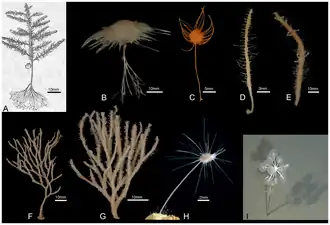Cladorhizidae
Cladorhizidae is a family of carnivorous demosponges found in deep-sea environments worldwide. These sponges are known for their unique feeding structures and predatory behavior, as they capture and consume small animals such as crustaceans.
| Cladorhizidae | |
|---|---|
 | |
| Representatives of the diversity of forms in Cladorhizidae | |
| Scientific classification | |
| Domain: | Eukaryota |
| Kingdom: | Animalia |
| Phylum: | Porifera |
| Class: | Demospongiae |
| Order: | Poecilosclerida |
| Family: | Cladorhizidae Dendy, 1922[1] |
| Genera | |
|
See text | |
Description
The Cladorhizidae family is characterized by its branched and bushy growth form, which can reach up to 3 meters in length. The body is composed of a skeleton made of spicules, which provide structural support and defense against predators. The sponge's feeding structures are modified spicules, which can be long and pointed, or branched and club-shaped. One species is also bioluminescent.[2]
Habitat and distribution
Cladorhizidae sponges are typically found on oceanic ridges and seamount systems, where they attach to the seafloor and extend their feeding structures into the water column to capture passing prey. Due to their deep-sea habitat, little is known about the ecology and behavior of these sponges.
Discovery
Cladorhizidae sponges were first described by the British zoologist George Hartwig in 1887. Since then, numerous species have been discovered and described, including several new species in the Southwest Indian Ocean Ridge. These discoveries highlight the need for further exploration of deep-sea environments and the diversity of life that exists within them.
Ecology
Due to their predatory nature, Cladorhizidae sponges play an important role in the deep-sea ecosystem. They capture and consume small animals such as crustaceans, contributing to the flow of energy and nutrients within the ecosystem. However, little is known about the overall impact of Cladorhizidae sponges on the deep-sea ecosystem.
Research and conservation
Cladorhizidae sponges continue to be a subject of fascination for marine biologists, who aim to understand the evolution and ecology of these unique organisms. However, due to their deep-sea habitat and the challenges associated with studying them, much about these sponges remains unknown. Conservation efforts for deep-sea ecosystems, including those inhabited by Cladorhizidae sponges, are important for preserving the biodiversity and functioning of these systems.
Genera
The World Register of Marine Species includes the following genera:[1]
- Abyssocladia Lévi, 1964[3]
- Abyssosdiskos Ekins, Erpenbeck, Goudie & Hooper, 2020
- Asbestopluma Topsent, 1901
- Axoniderma Ridley & Dendy, 1886[3]
- Bathytentacular Ekins, Erpenbeck, Goudie & Hooper, 2020[3][4]
- Cercicladia Rios, Kelly & Vacelet, 2011
- Chondrocladia Thomson, 1873
- Cladorhiza Sars, 1872
- Euchelipluma Topsent, 1909
- Koltunicladia Hestetun, Vacelet, Boury-Esnault, Borchiellini, Kelly, Rios, Cristobo & Rapp, 2016
- Lollipocladia Vacelet, 2008
- Lycopodina Lundbeck, 1905[3]
- Nullarbora Ekins, Erpenbeck, Goudie & Hooper, 2020[3]
References
- van Soest, Rob (2013). "Cladorhizidae Dendy, 1922". WoRMS. World Register of Marine Species. Retrieved 2021-01-18.
- Researchers discover carnivorous sponges that make their own light
- Merrick Ekins, Dirk Erpenbeck, Lisa Goudie, John N. A. Hooper: New carnivorous sponges and allied species from the Great Australian Bight. In: ZooTaxa Volume 4878, No. 2. Jan 2021. doi:10.11646/zootaxa.4878.2.2. Along with:
- Watch out they Bight! Three new Carnivorous sponges found in Great Australian Bight. On: scimex.org. 15 January 2021. Queensland Museum Media Release.
- Jacinta Bowler: Scientists Just Discovered 3 New Kinds of Carnivorous Sponge in The Deep Ocean. On: sciencealert. 18 January 2021.
- Bathytentacular Ekins, Erpenbeck, Goudie & Hooper, 2020. On: WoRMS